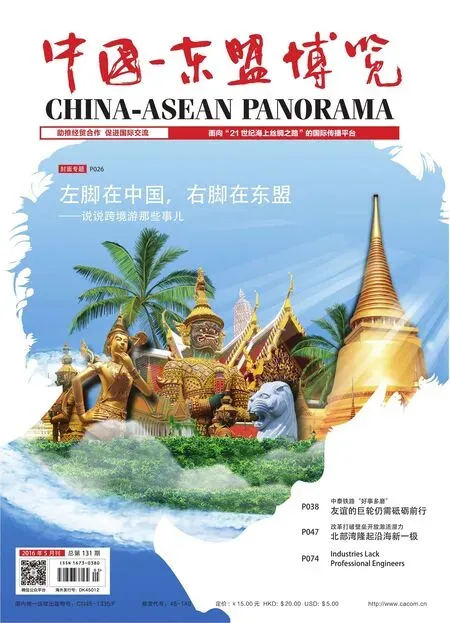Establishing Stronger Cooperation between Malaysia and China
--An exclusive interview with the Ambassador of Malaysia to China,H. E. Datuk Zainuddin Yahya
Written by Li Min, Li Yizhi / Translated by Han Rong, Li Jie
Establishing Stronger Cooperation between Malaysia and China
--An exclusive interview with the Ambassador of Malaysia to China,H. E. Datuk Zainuddin Yahya
Written by Li Min, Li Yizhi / Translated by Han Rong, Li Jie

M alaysia was the first ASEAN country to establish diplomatic relations with China. Since its establishment in 1974, bilateral relations between the two countries have been on a forward momentum and have grown from strength to strength, with Malaysia currently being China's largest trading partner among the ASEAN countries. At a meeting with Malaysia's Prime Minister Dato Seri' Mohd Najib Tun Abdul Razak at the Boao Forum for Asia in 2015, President Xi Jinping mentioned that China-Malaysia relations were at their best in history. The pivotal question however is, how can the two countries continue to maintain and strengthen this fast pace of positive developments? Are there more cooperation potentials to tap between China and Malaysia? To answer some of these questions, China-ASEAN Panorama interviewed H. E. Datuk Zainuddin Yahya, the Ambassador of Malaysia to the People's Republic of China.
Seven-star Overseas Assignment
China-ASEAN Panorama: China and Malaysia have made big headways in all areas since the establishment of diplomatic relations over 40 years ago. In your position as the Ambassador, what do you think will be the spillover effects of the existing close relations between both countries?
Datuk Zainuddin Yahya: It has been over a year since I arrived in Beijing in mid-January, 2015. China is definitely an interesting assignment. With a large geographical area, there are considerable differences between the various Provinces and cities. For example, the landscape and cultures varies from the northern, central, eastern and southern part of China. I have so far visited over 20 cities including first, second and third-tier cities since assuming this post; all these places have their own unique features and characteristics. I suppose Southern part of China is quite similar to Malaysia. One of my diplomatic colleagues often refers to China as a “seven-star overseas assignment”. I certainly concur with him given the current rapid development and changes taking place in China.
As you are aware, China is an important trading partner of Malaysia: It has been Malaysia's largest trading partner since 2009; with bilateral trade achieving US$ 97 billion in 2015. The target is to attain US$ 160 billion by 2017. In this connection, as the Malaysian Ambassador to China, I have to ensure that these trade figures are achieved and therefore need to work hard to further boost and strengthen the bilateral relations between both countries, especially in the economic sphere. Since Malaysia-China current relations are at their best in history, I am confident that both our countries will fully capitalize the current state of affairs and effectively play our respective part to further strengthen and deepen this relationship and collaboration in all areas including trade and investment, education, cultural and tourism.
Establishing China-Malaysia Free Trade Agreement
China-ASEAN Panorama: The negotiations on anupgraded China-ASEAN Free Trade Area (FTA) were successfully concluded at the end of 2015. In your opinion, what are the positive effects of the upgraded China-ASEAN FTA on the two countries' commodity trade, service trade and two-way investment? Please also update us on the latest development of Malaysia's tourism and its appeal to investors.
Datuk Zainuddin Yahya: The signing of the China-ASEAN Free Trade Area (FTA) is a positive development and an excellent attempt for expanding trade and investment between China and ASEAN. The upgraded FTA will undoubtedly further help to boost trade relations and have a positive impact on trade liberalization, investment facilitation, trade expansion,and non-tariff barrier reduction, etc. between ASEAN and China. We expect the “upgraded” FTA, which is currently undergoing the necessary domestic approval procedures, to come into force by this year.
Personally, I think Malaysia and China should also seriously consider signing a bilateral FTA to address specific trade related issues and constraints faced by both exporters. It is envisaged that the signing of an FTA between Malaysia and China would further increase the trade volume between both countries. The China-Malaysia FTA and the upgraded China-ASEAN FTA would complement each other.
On tourism industry, Malaysia has always attached great importance on the development and promotion of its tourism sector as it is one of the major revenue contributors to the country. The Malaysian Government has introduced many programs and has done a lot to promote Malaysia as an attractive and popular tourist destination in the region. Malaysia has a lot to offer as aptly refl ected in its tagline “Malaysia Truly Asia.” For example, “Malaysia My Second Home or MM2H” was an initiative promoted and supported by the Government of Malaysia to allow people from all over the world who fulfil certain criteria, to stay in Malaysia as long as possible on a social visit pass with a multiple entry visa. It is open to citizens of all countries regardless of race, religion,gender or age. Since its introduction in 2002, Chinese nationals have become the number one participant of the MM2H program. As of December 2015, a total of 6,923 Chinese nationals have successfully qualified for the MM2H program.
Certainly, Malaysia hopes to see more Chinese tourists coming to Malaysia. The number of Chinese tourists who visited Malaysia was 1.68 million in 2015 and this fi gure is expected to increase. Recently,the Government of Malaysia has taken positive measures to make it easier for the Chinese tourists wanting to travel to Malaysia. One example is that the Chinese tourists residing in China can now enjoy visa-free visits to Malaysia within 15 days beginning from March 1 to December 31, 2016. Therefore, if you want to visit Malaysia today, you only need to submit an online application and entry document will be issued immediately. Fast and simple. Just visit the designated website www.windowmalaysia.my.
By visiting Malaysia, it is my fervent hope that tourists from China will have a better understanding of its people, culture, and tradition and business environment. This is pertinent to promote “peopleto-people” contact. With this acquired information and knowledge about Malaysia, you will be more confident when you decide to invest or do business in the country. In other words, if you do not know a country well, you certainly would hesitate to invest in that country. At present, unfortunately, investment tilts heavily in China's favour with investors from China invested only 1 dollar in Malaysia for every 6 dollars invested by Malaysians in China. Therefore,I am determined to rectify this asymmetrical and see more Chinese investors investing in Malaysia,especially against the backdrop of China's policy to promote “global cooperation on production capacity” by encouraging more of its companies to invest abroad. China plans to invest US$ 500billion abroad over the next 5 years from 2014 and this will certainly provide opportunities for Malaysia to attract more Chinese investments by exploring the complementarities offered by the economic transformation which is taking place in both countries.
Having said that, in wanting to achieve a high income developed nation status by 2020, Malaysia has no choice but to move to high-value chain by attracting capital intensive and knowledge based industries, creating more jobs for skilled workers and less dependence on unskilled foreign workers. In essence, Malaysia needs more innovative industries using green technology with higher added value.
Malaysia, a believer in global cooperation in production capacity
China-ASEAN Panorama: China is calling for “global cooperation on production capacity”. What do you think about this cooperation between China and ASEAN countries? In which areas can China and Malaysia carry out this cooperation? Will the High Speed Rail Project be the part of it?
Datuk Zainuddin Yahya: In the Joint Statement issued at the conclusion of the Official Visit by Prime Minster Li Keqiang to Malaysia in November 2015,both leaders mentioned that enhancing cooperation in production capacity and equipment manufacturing has great potential and will contribute to bilateral trade and mutual development of both countries. To this end, Malaysia and China signed the Agreement on Enhancing Cooperation in Production Capacity and Investment to allow both countries to further enhance the development of trade,economic and investment cooperation.
Malaysia is in favour of working closely with China in this area of production capacity cooperation. However, as mentioned earlier; Malaysia at the sametime needs to be selective on the types of industry or FDI it intends to attract. With a small population of approximately 30 million people, we need to concentrate on high-tech manufacturing and green technology, with dependence on unskilled foreign workers.
With regard to the proposed high speed rail project from Kuala Lumpur to Singapore, we are still working on it. The Project remains a priority for my Government. A few countries, including China, have expressed their interests to partake in the project. The Government of Malaysia is still in the midst of discussions with Singapore. Upon reaching an agreement, we will initiate an open and transparent international bidding process. The most comprehensive, favorable and attractive offer will be accepted.
Malaysia as an Education Center of Excellence
China-ASEAN Panorama: 2016 has been declared as the year of educational exchange between China and ASEAN. Recent years have also witnessed positive progress in education cooperation between China and Malaysia; for example, the Malaysian branch campus of China's Xiamen University was recently established in Malaysia. What are the advantages of studying in Malaysia? and are there any new plans for cooperation in this sector between both countries?
Datuk Zainuddin Yahya: Strengthening cooperation in the education sector between China and Malaysia has been on a positive momentum in recent years. The presence of several hundred governmentsponsored Malaysian students studying Chinese language in universities such as Beijing Foreign Studies University (BFSU) and Beijing Language and Culture University (BLCU) reflects the seriousness of the Malaysian government on education strengthening cooperation between both countries. As of December 2015, a total of 814 Malaysian students were pursuing their higher education in China. While from China, a total of 8,371 Chinese students were pursuing higher education in Malaysia. Malaysia also welcomes China's decision to offer 1,000 scholarships to students from ASEAN Member States within the next 3 years. Presently, there are over 190,000 students from ASEAN and China that are currently studying in each other's country respectively.
In terms of the advantages of studying in Malaysia, I am pretty sure that more Chinese parents, especially from the middle-income group, would consider Malaysia as an education destination for their children's higher education.
Early of this year, China's Xiamen University branch campus in Malaysia has begun its first intake. It was the first Chinese university to set up a branch overseas. I hope more top Chinese universities will establish their campuses in Malaysia. The Malaysian branch campus of Xiamen University is opened not only to local students but also international students including from China. The design and façade of the campus is very impressive. It is the largest branch campus in Malaysia among all the foreign campuses in Malaysia.
I have also been informed that a Chinese international school to be managed and administered by China's Shanghai Jiaotong University will be established soon in Malaysia. The objective of this school is to attract students from China as well as children whose parents are part of the “MM2H” programme including our local students. Studying in an international school will help better prepare and provide opportunities for these students to pursue their studies in our local universities or abroad.

